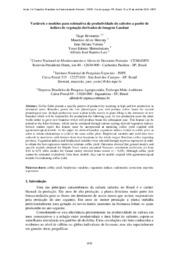Variáveis e modelos para estimativa da produtividade do cafeeiro a partir de índices de vegetação derivados de imagens Landsat.
Variáveis e modelos para estimativa da produtividade do cafeeiro a partir de índices de vegetação derivados de imagens Landsat.
Autoria: BERNARDES, T.; MOREIRA, M. A.; VERONA, J. D.; SHIMABUKURO, Y. E.; LUIZ, A. J. B.
Resumo: Abstract. Coffee fields present a specific pattern of productivity resulting in high and low production in alternated years. Branches grown the first phenological year will produce coffee beans the second phenological year. In high-production years a plant works mostly to grain-filling to the detriment of new branches which will be responsible for production the following year. In low-production years the plant works rather to grow new branches which will produce beans the subsequent year. This feature can be related to the foliar biomass, which can be estimated through remote sensing derived vegetation indices. Several studies report this feature must be incorporated in modeling coffee yield coupled with agrometeorogical models. In this paper we derived Landsat vegetation indices related to coffee plots in order to obtain relationships to yield of the same coffee plots. Biophisical variables and yield data were colected in interviews with farmers from four locations in the whole largest Brazilian coffee-exporting province. Vegetation indices and biophysical variables were selected through stepwise regression in order to obtain the best regression models to estimate coffee yield. Outcomes showed that general models and specific models obtained for Mundo Novo variety presented Pearson's correlation coeficients (r) from 0,64 to 0,71 while models for Catuaí variety showed better results (r = 0,85). Although coffee yield cannot be estimated exclusively from these models, they can be usefull coupled with agrometeorogical models for estimating coffee yield.
Ano de publicação: 2013
Tipo de publicação: Artigo em anais e proceedings
Unidade: Embrapa Meio Ambiente
Observações
1 - Por padrão são exibidas publicações dos últimos 20 anos. Para encontrar publicações mais antigas, configure o filtro ano de publicação, colocando o ano a partir do qual você deseja encontrar publicações. O filtro está na coluna da esquerda na busca acima.
2 - Para ler algumas publicações da Embrapa (apenas as que estão em formato ePub), é necessário ter, no celular ou computador, um desses softwares gratuitos. Sistemas Android: Google Play Livros; IOS: iBooks; Windows e Linux: software Calibre.
Acesse outras publicações
Acesse a Base de Dados da Pesquisa Agropecuária (BDPA) para consultar o acervo completo das bibliotecas da Embrapa.

